Construction and Application of Feature Recommendation Model for Remote Sensing Interpretation of Rock Strata Based on Knowledge Graph
Abstract
1. Introduction
- (1)
- Geological Remote Sensing Knowledge Graph Construction: A fine-tuned Universal Information Extraction (UIE) model is used to construct a geological knowledge graph from unstructured text. The KG is then utilized to compute semantic similarity indicators, identifying the most relevant interpretation features of rock strata and establishing a susceptibility evaluation factor system.
- (2)
- Feature Evaluation and Model Performance: Random Forest (RF) and Support Vector Machine (SVM) models assess the effectiveness of the recommended features. The experimental results show overall accuracies of 81.79% and 75.76%, with Kappa coefficients of 0.71 and 0.65, respectively. These results confirm the robustness of the feature model and its applicability to field geological surveys in complex and previously unexplored geological environments.
2. Study Area and Data Sources
2.1. Study Area
2.2. Data Sources
2.2.1. Remote Sensing Data
2.2.2. Knowledge Graph Modeling Data
2.2.3. Sample Points Dataset
3. The Proposed Methodology
3.1. Knowledge Graph Construction
3.1.1. Knowledge Graph Construction Process
3.1.2. Knowledge Modeling
3.1.3. UIE Model
3.2. The Knowledge-Graph-Based Rock Strata Remote Sensing Interpretation Feature Recommendation Model
3.2.1. Knowledge Graph Representation Learning
3.2.2. Semantic Similarity
- Xishanyao Group: {Sandstone, Conglomerate, Mudstone};
- Kepingtage Group: {Sandstone, Mudstone}.
- Xishanyao Group ∆ Kepingtage Group = {Conglomerate};
- Xishanyao Group Kepingtage Group = {Sandstone, conglomerate, Mudstone};
- .
3.3. Remote Sensing Interpretation Machine Learning Models and Accuracy Testing
3.3.1. Support Vector Machine
3.3.2. Random Forest
3.3.3. Model Accuracy Evaluation
4. Experiment Results and Analysis
4.1. Construction of Remote Sensing Feature Knowledge Graph for Geological Mapping Objects
4.1.1. Text Data Annotation
4.1.2. Model Pre-Training and Knowledge Extraction
4.1.3. Knowledge Integration and Storage
4.2. Rock Strata Unit Classification Supported by the Knowledge Graph
4.3. Remote Sensing Interpretation of Rock Strata
4.3.1. Stratification Accuracy
4.3.2. Remote Sensing Interpretation Analysis
4.4. Comparison Experiment
5. Discussion
6. Conclusions and Future Work
Author Contributions
Funding
Data Availability Statement
Acknowledgments
Conflicts of Interest
References
- Howard, A.S.; Hatton, B.; Reitsma, F.; Lawrie, K.I. Developing a geoscience knowledge framework for a national geological survey organization. Comput. Geosci. 2009, 35, 820–835. [Google Scholar] [CrossRef]
- Yao, Z.; Du, Z. Strategic thinking on the geological survey work in the New Era. Geol. Bull. China 2018, 37, 2120–2124. [Google Scholar]
- Han, W.; Zhang, X.; Wang, Y.; Wang, L.; Huang, X.; Li, J.; Wang, S.; Chen, W.; Li, X.; Feng, R.; et al. A survey of machine learning and deep learning in remote sensing of geological environment: Challenges, advances, and opportunities. ISPRS J. Photogramm. Remote Sens. 2023, 202, 87–113. [Google Scholar] [CrossRef]
- Wang, C.; Ma, X.; Chen, J.; Chen, J. Information extraction and knowledge graph construction from geoscience literature. Comput. Geosci. 2018, 112, 112–120. [Google Scholar] [CrossRef]
- Qiu, Q.; Xie, Z.; Wu, L.; Tao, L. Automatic spatiotemporal and semantic information extraction from unstructured geoscience reports using text mining techniques. Earth Sci. Inform. 2020, 13, 1393–1410. [Google Scholar] [CrossRef]
- Goetz, A.F.H.; Rowan, L.C. Geologic remote sensing. Science 1981, 211, 781–791. [Google Scholar] [CrossRef]
- Rezaei, A.; Hassani, H.; Moarefvand, P.; Golmohammadi, A. Lithological mapping in Sangan region in Northeast Iran using ASTER satellite data and image processing methods. Geol. Ecol. Landsc. 2020, 4, 59–70. [Google Scholar] [CrossRef]
- Bachri, I.; Hakdaoui, M.; Raji, M.; Teodoro, A.C.; Benbouziane, A. Machine learning algorithms for automatic lithological mapping using remote sensing data: A case study from Souk Arbaa Sahel, Sidi Ifni Inlier, Western Anti-Atlas, Morocco. ISPRS Int. J. Geo-Inf. 2019, 8, 248. [Google Scholar] [CrossRef]
- Testa, F.J.; Villanueva, C.; Cooke, D.R.; Zhang, L. Lithological and hydrothermal alteration mapping of epithermal, porphyry and tourmaline breccia districts in the Argentine Andes using ASTER imagery. Remote Sens. 2018, 10, 203. [Google Scholar] [CrossRef]
- Ninomiya, Y.; Fu, B. Thermal infrared multispectral remote sensing of lithology and mineralogy based on spectral properties of materials. Ore Geol. Rev. 2019, 108, 54–72. [Google Scholar] [CrossRef]
- Ghoneim, S.M.; Yehia, M.A.; Salem, S.M.; Ali, H.F. Integrating remote sensing data, GIS analysis and field studies for mapping alteration zones at Wadi Saqia area, central Eastern Desert, Egypt. Egypt. J. Remote Sens. Space Sci. 2022, 25, 323–336. [Google Scholar] [CrossRef]
- Chen, Q.; Xia, J.; Zhao, Z.; Zhou, J.; Zhu, R.; Zhang, R.; Zhao, X.; Chao, J.; Zhang, X.; Zhang, G. Interpretation of hydrothermal alteration and structural framework of the Huize Pb–Zn deposit, SW China, using Sentinel-2, ASTER, and Gaofen-5 satellite data: Implications for Pb–Zn exploration. Ore Geol. Rev. 2022, 150, 105154. [Google Scholar] [CrossRef]
- Mahanta, P.; Maiti, S. Regional scale demarcation of alteration zone using ASTER imageries in South Purulia Shear Zone, East India: Implication for mineral exploration in vegetated regions. Ore Geol. Rev. 2018, 102, 846–861. [Google Scholar] [CrossRef]
- Ousmanou, S.; Fozing, E.M.; Kwékam, M.; Fodoue, Y.; Jeatsa, L.D.A. Application of remote sensing techniques in lithological and mineral exploration: Discrimination of granitoids bearing iron and corundum deposits in southeastern Banyo, Adamawa region-Cameroon. Earth Sci. Inform. 2023, 16, 259–285. [Google Scholar] [CrossRef]
- Qiu, Q.; Xie, Z.; Zhang, D.; Ma, K.; Tao, L.; Tan, Y.; Zhang, Z.; Jiang, B. Knowledge graph for identifying geological disasters by integrating computer vision with ontology. J. Earth Sci. 2023, 34, 1418–1432. [Google Scholar] [CrossRef]
- Wang, J.; Cao, W. A Novel Approach for Mining Spatiotemporal Explicit and Implicit Information in Multiscale Spatiotemporal Data. ISPRS Int. J. Geo-Inf. 2023, 12, 261. [Google Scholar] [CrossRef]
- Hettne, K.M.; Stierum, R.H.; Schuemie, M.J.; Hendriksen, P.J.; Schijvenaars, B.J.; Mulligen, E.M.; Kleinjans, J.; Kors, J.A. A dictionary to identify small molecules and drugs in free text. Bioinformatics 2009, 25, 2983–2991. [Google Scholar] [CrossRef]
- Morwal, S.; Jahan, N.; Chopra, D. Named entity recognition using hidden Markov model (HMM). Int. J. Nat. Lang. Comput. 2012, 1, 15–23. [Google Scholar] [CrossRef]
- Abdallah, S.; Shaalan, K.; Shoaib, M. Integrating rule-based system with classification for arabic named entity recognition. In Proceedings of the International Conference on Intelligent Text Processing and Computational Linguistics, Delhi, India, 11–17 March 2012; Springer: Berlin/Heidelberg, Germany, 2012; pp. 311–322. [Google Scholar]
- Bam, S.B.; Shahi, T.B. Named entity recognition for nepali text using support vector machines. Intell. Inf. Manag. 2014, 6, 21–29. [Google Scholar] [CrossRef]
- Liu, H.; Qiu, Q.; Wu, L.; Li, W.; Wang, B.; Zhou, Y. Few-shot learning for name entity recognition in geological text based on GeoBERT. Earth Sci. Inform. 2022, 15, 979–991. [Google Scholar] [CrossRef]
- Lv, X.; Xie, Z.; Xu, D.; Jin, X.; Ma, K.; Tao, L.; Qiu, Q.; Pan, Y. Chinese named entity recognition in the geoscience domain based on BERT. Earth Space Sci. 2022, 9, e2021EA002166. [Google Scholar] [CrossRef]
- Qiu, Q.; Wang, B.; Ma, K.; Lü, H.; Tao, L.; Xie, Z. A practical Approach to constructing a geological knowledge graph: A case study of Mineral Exploration Data. J. Earth Sci. 2023, 34, 1374–1389. [Google Scholar] [CrossRef]
- Qiu, Q.; Ma, K.; Lv, H.; Tao, L.; Xie, Z. Construction and application of a knowledge graph for iron deposits using text mining analytics and a deep learning algorithm. Math. Geosci. 2023, 55, 423–456. [Google Scholar] [CrossRef]
- Tian, M.; Ma, K.; Wu, Q.; Qiu, Q.; Tao, L.; Xie, Z. Joint extraction of entity relations from geological reports based on a novel relation graph convolutional network. Comput. Geosci. 2024, 187, 105571. [Google Scholar] [CrossRef]
- Zhang, L.; Hou, M.; Chen, A.; Zhong, H.; Ogg, J.G.; Zheng, D. Construction of a fluvial facies knowledge graph and its application in sedimentary facies identification. Geosci. Front. 2023, 14, 101521. [Google Scholar] [CrossRef]
- Tang, X.; Feng, Z.; Xiao, Y.; Wang, M.; Ye, T.; Zhou, Y.; Meng, J.; Zhang, B.; Zhang, D. Construction and application of an ontology-based domain-specific knowledge graph for petroleum exploration and development. Geosci. Front. 2023, 14, 101426. [Google Scholar] [CrossRef]
- Roy, D.P.; Wulder, M.A.; Loveland, T.R.; Woodcock, C.E.; Allen, R.G.; Anderson, M.C.; Helder, D.; Irons, J.R.; Johnson, D.M.; Kennedy, R.; et al. Landsat-8: Science and product vision for terrestrial global change research. Remote Sens. Environ. 2014, 145, 154–172. [Google Scholar] [CrossRef]
- Lu, Y.; Liu, Q.; Dai, D.; Xiao, X.; Lin, H.; Han, X.; Sun, L.; Wu, H. Unified structure generation for universal information extraction. In Proceedings of the 60th Annual Meeting of The Association for Computational Linguistics, Dublin, Ireland, 22–27 May 2022; pp. 5755–5772. [Google Scholar]
- Bordes, A.; Usunier, N.; Garcia-Duran, A.; Weston, J.; Yakhnenko, O. Translating embeddings for modeling multi-relational data. Adv. Neural Inf. Process. Syst. 2013, 26, 2787–2795. [Google Scholar]
- Li, J.; Xiang, J.; Cheng, J. EARR: Using rules to enhance the embedding of knowledge graph. Expert Syst. Appl. 2023, 232, 120831. [Google Scholar] [CrossRef]
- Kakad, S.; Dhage, S. Cross domain-based ontology construction via Jaccard Semantic Similarity with hybrid optimization model. Expert Syst. Appl. 2021, 178, 115046. [Google Scholar] [CrossRef]
- Bai, L.; Song, X.; Zhu, L. Joint Multi-Feature Information Entity Alignment for Cross-Lingual Temporal Knowledge Graph with BERT. IEEE Trans. Big Data 2024, 1–13. [Google Scholar] [CrossRef]
- Hearst, M.A.; Dumais, S.T.; Osuna, E.; Platt, J.; Scholkopf, B. Support vector machines. IEEE Intell. Syst. Their Appl. 1998, 13, 18–28. [Google Scholar] [CrossRef]
- Roy, A.; Chakraborty, S. Support vector machine in structural reliability analysis: A review. Reliab. Eng. Syst. Saf. 2023, 233, 109126. [Google Scholar] [CrossRef]
- Breiman, L. Random forests. Mach. Learn. 2001, 45, 5–32. [Google Scholar] [CrossRef]
- Hu, J.; Szymczak, S. A review on longitudinal data analysis with random forest. Brief. Bioinform. 2023, 24, bbad002. [Google Scholar] [CrossRef]
- Townsend, J.T. Theoretical analysis of an alphabetic confusion matrix. Percept. Psychophys. 1971, 9, 40–50. [Google Scholar] [CrossRef]
- Zhao, Y.; Zhu, W.; Wei, P.; Fang, P.; Zhang, X.; Yan, N.; Liu, W.; Zhao, H.; Wu, Q. Classification of Zambian grasslands using random forest feature importance selection during the optimal phenological period. Ecol. Indic. 2022, 135, 108529. [Google Scholar] [CrossRef]
- Shu, Y.; Ma, Y.; Li, W.; Hu, G.; Wang, X.; Zhang, Q. Unraveling the dynamics of social governance innovation: A synergistic approach employing NLP and network analysis. Expert Syst. Appl. 2024, 255, 124632. [Google Scholar] [CrossRef]
- Wu, Q.; Xie, Z.; Tian, M.; Qiu, Q.; Chen, J.; Tao, L.; Zhao, Y. Integrating Knowledge Graph and Machine Learning Methods for Landslide Susceptibility Assessment. Remote Sens. 2024, 16, 2399. [Google Scholar] [CrossRef]
- Qasim, M.; Khan, S.D.; Haider, R.; Ur Rashid, M. Integration of multispectral and hyperspectral remote sensing data for lithological mapping in Zhob Ophiolite, Western Pakistan. Arab. J. Geosci. 2022, 15, 599. [Google Scholar] [CrossRef]
- Jiang, G.; Chen, X.; Wang, J.; Wang, S.; Zhou, S.; Bai, Y.; Liao, T.; Yang, H.; Ma, K.; Fan, X. Estimation of the multielement content in rocks based on a combination of visible–near-infrared reflectance spectroscopy and band index analysis. Remote Sens. 2023, 15, 3591. [Google Scholar] [CrossRef]
- Xi, Y.; Mohamed Taha, A.M.; Hu, A.; Liu, X. Accuracy comparison of various remote sensing data in lithological classification based on random forest algorithm. Geocarto Int. 2022, 37, 14451–14479. [Google Scholar] [CrossRef]
- Albert, G.; Ammar, S. Application of random forest classification and remotely sensed data in geological mapping on the Jebel Meloussi area (Tunisia). Arab. J. Geosci. 2021, 14, 2240. [Google Scholar] [CrossRef]
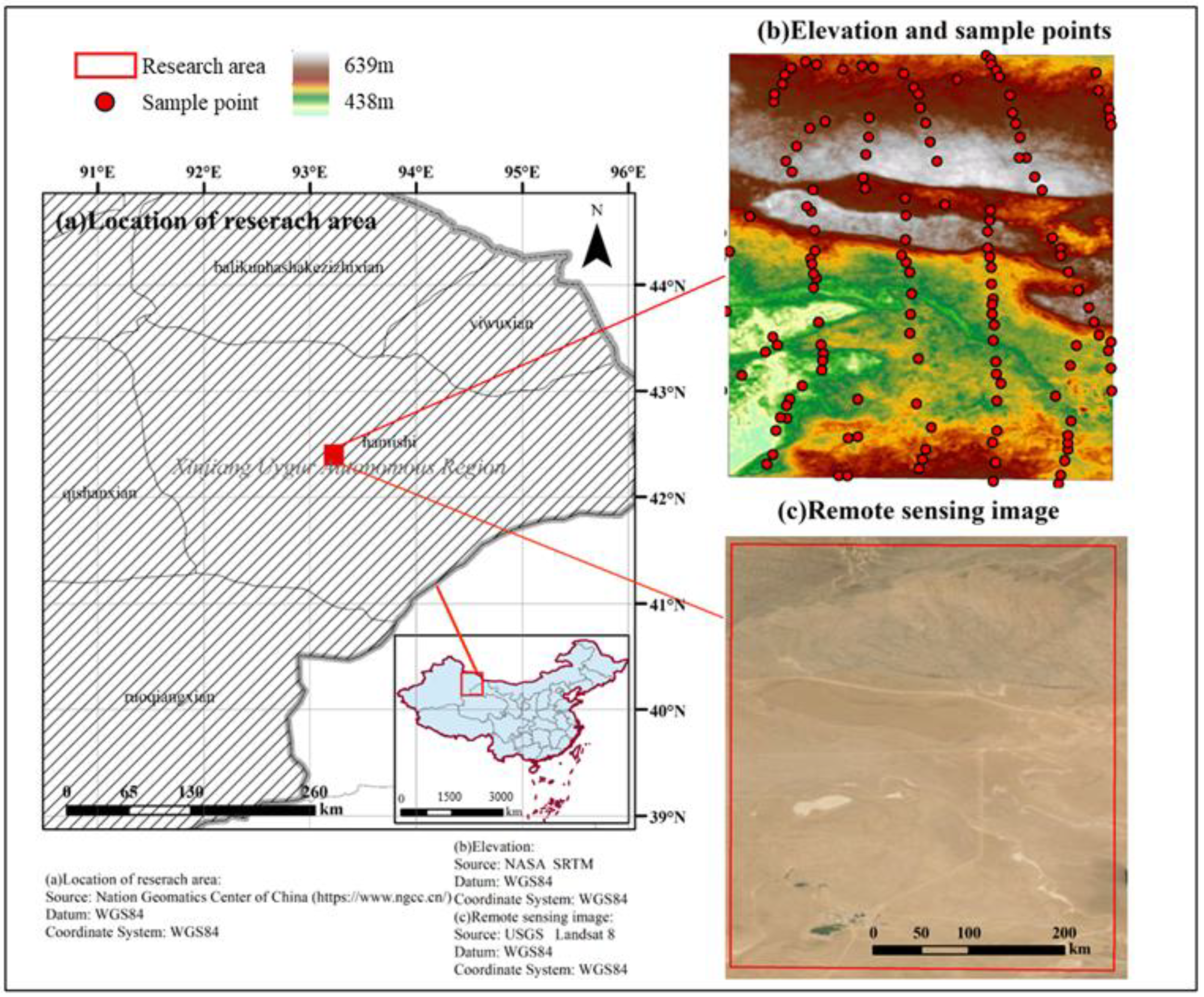
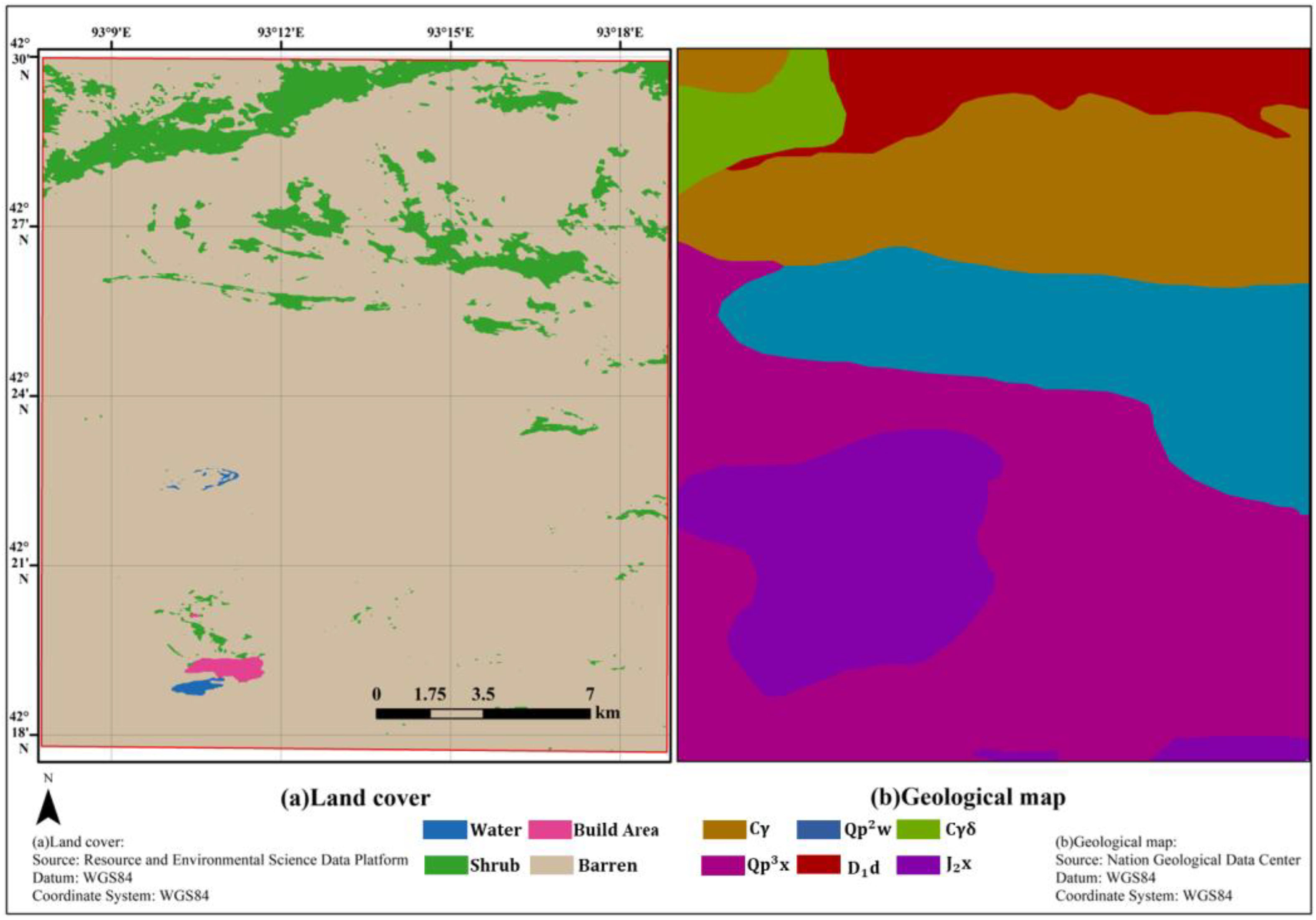
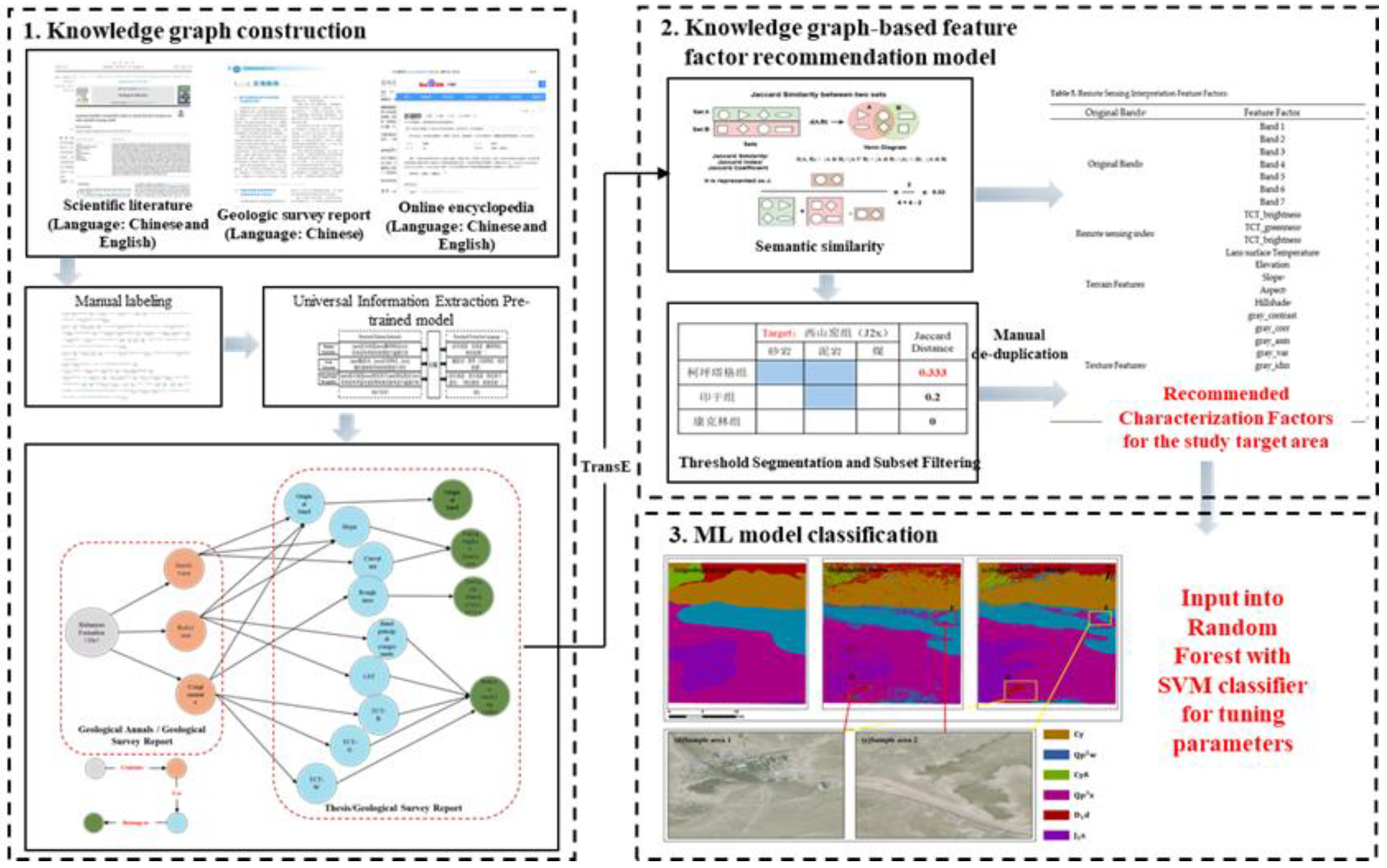



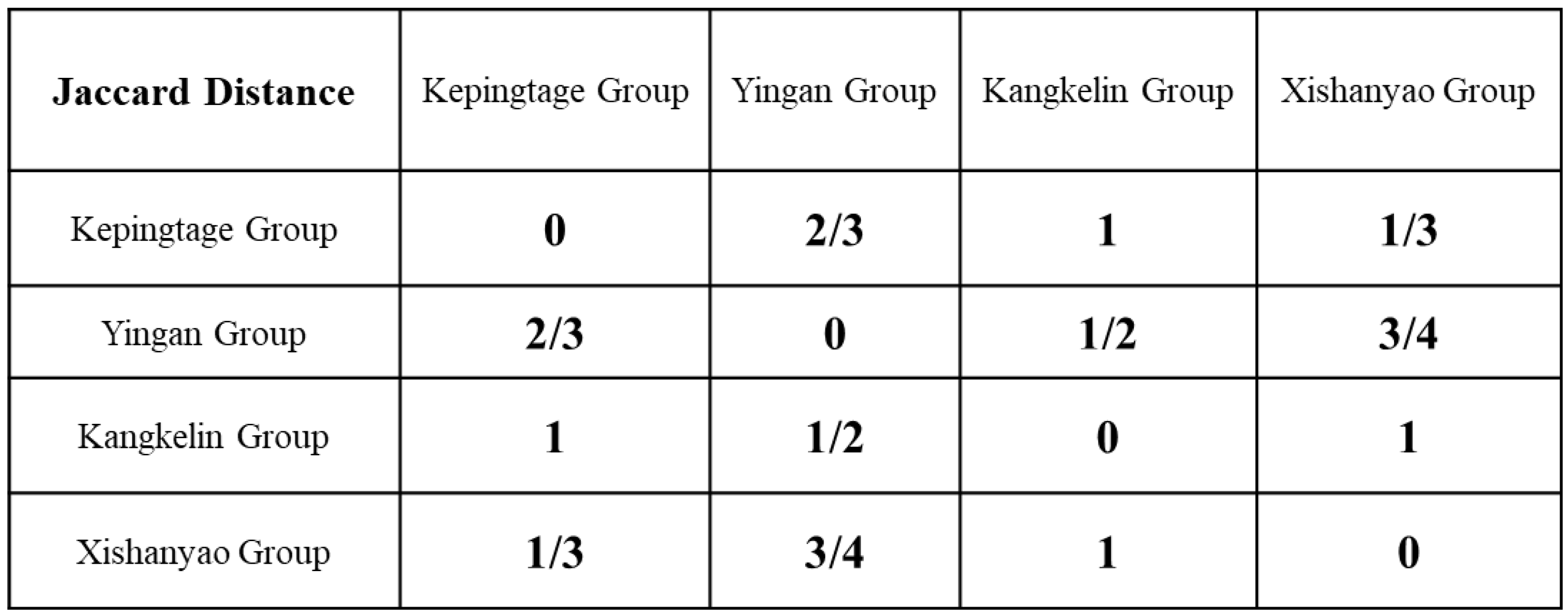
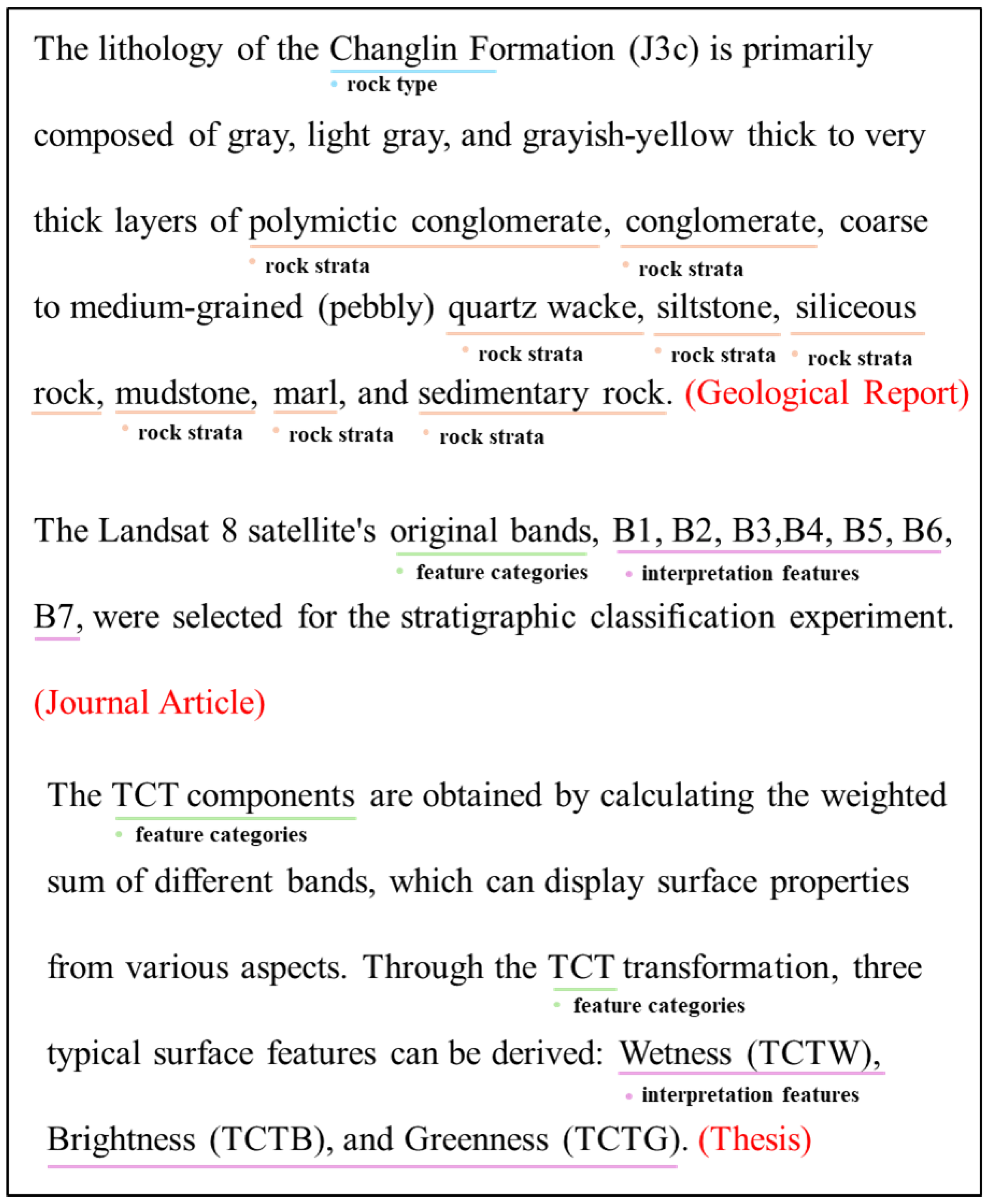

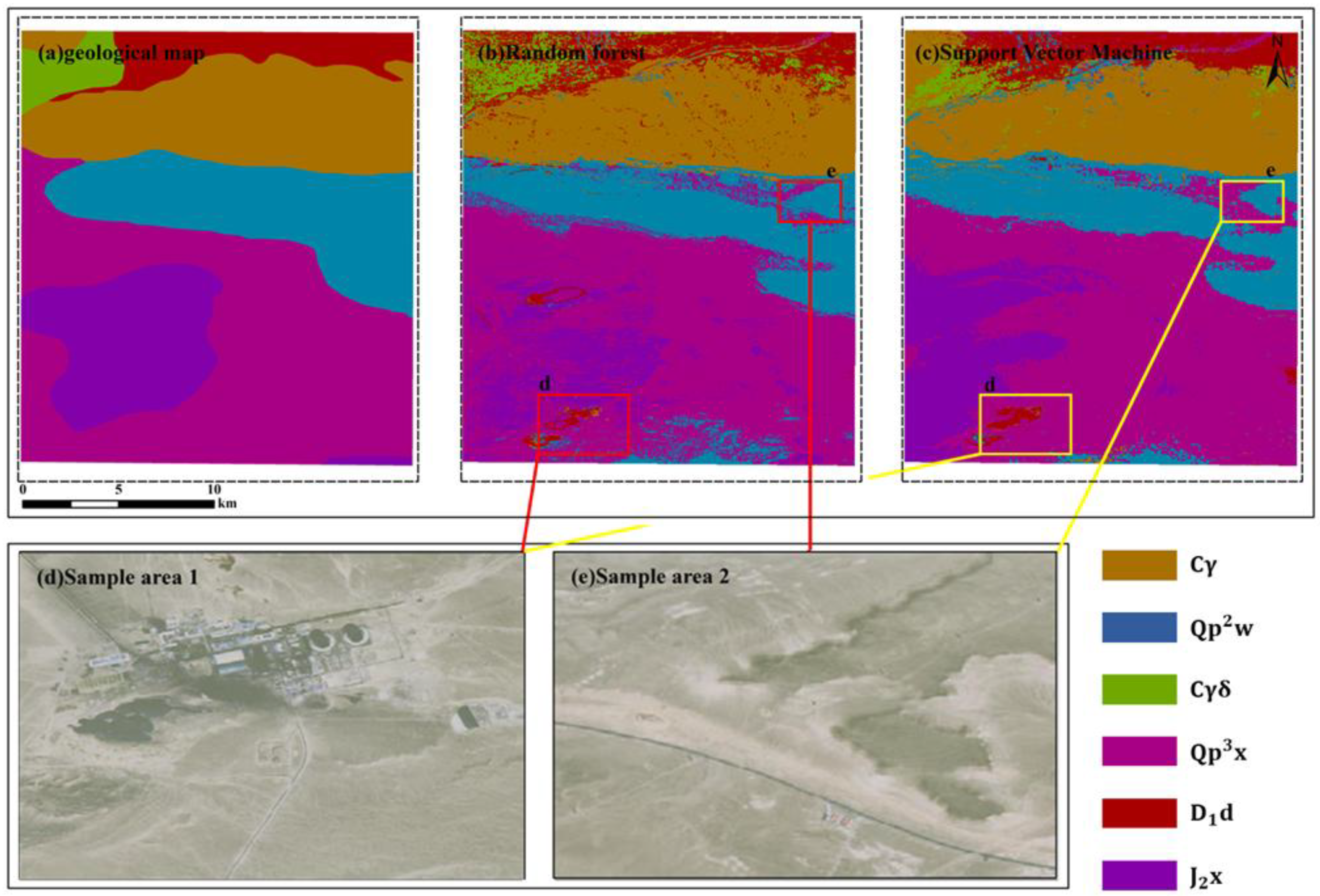

| Data Type | Data Description | Spatial Resolution | Data Sources |
|---|---|---|---|
| Multi-spectral remote sensing imagery | Landsat 8 imagery capturing various spectral bands for land cover and geological analysis | 30 m | USGS Earth Explorer |
| Digital Elevation Imaging | ASTER Digital Elevation Model (DEM) used for topographic analysis and elevation data | 30 m | NASA Earth data |
| Class Name | Code | Number of Sample Points |
|---|---|---|
| ) | 1 | 144 |
| ) | 2 | 45 |
| ) | 3 | 65 |
| ) | 4 | 15 |
| ) | 5 | 67 |
| ) | 6 | 82 |
| Total | 418 |
| Head Entity | Relationship | Tail Entity |
|---|---|---|
| Rock Strata | Contains | Rock Category |
| Rock Strata | Uses | Remote Sensing Feature |
| Rock Strata | Uses | Remote Sensing Feature |
| Rock Strata | Belongs to | Feature Category |
| Precision | Recall | F1 Score | ||
|---|---|---|---|---|
| Entity | Rock type | 89.68% | 75.99% | 80.30% |
| Rock strata | 78.64% | 72.81% | 79.54% | |
| Interpretation Features | 79.99% | 62.38% | 69.72% | |
| Feature Category | 19.33% | 10.50% | 11.71% | |
| Relationships | Contain | 91.87% | 89.63% | 85.73% |
| Uses | 67.99% | 55.23% | 64.83% | |
| Belongs to | 23.69% | 21.34% | 33.80% |
| Original Bands | Feature Factor |
|---|---|
| Original Bands | Band 1 |
| Band 2 | |
| Band 3 | |
| Band 4 | |
| Band 5 | |
| Band 6 | |
| Band 7 | |
| Remote sensing index | TCT_brightness |
| TCT_greenness | |
| TCT_brightness | |
| Lans surface Temperature | |
| Terrain features | Elevation |
| Slope | |
| Aspect | |
| Hillshade | |
| Texture features | gray_contrast |
| gray_corr | |
| gray_asm | |
| gray_var | |
| gray_idm | |
| gray_savg | |
| gray_svar | |
| gray_sent | |
| gray_ent |
| Model | Xinjiang Group () | Dananhu Group () | Granite () | Granodiorite () | Wusu Group () | Xishanyao Group () |
|---|---|---|---|---|---|---|
| RF | 0.78 | 0.74 | 0.92 | 0.20 | 0.79 | 0.75 |
| SVM | 0.72 | 0.44 | 0.86 | 0.17 | 0.78 | 0.63 |
| Xinjiang Group () | Dananhu Group () | Granite () | Granodiorite () | Wusu Group () | Xishanyao Group () | |
|---|---|---|---|---|---|---|
| Xinjiang Group () | 112 | 0 | 0 | 0 | 20 | 12 |
| Dananhu Group () | 0 | 33 | 7 | 2 | 0 | 0 |
| Granite () | 0 | 2 | 60 | 3 | 0 | 0 |
| Granodiorite () | 0 | 11 | 1 | 3 | 0 | 0 |
| Wusu Group () | 10 | 1 | 4 | 0 | 51 | 10 |
| Xishanyao Group () | 18 | 2 | 0 | 0 | 0 | 62 |
| Data Type | Model | Overall Accuracy | Kappa |
|---|---|---|---|
| Individual reflectance | RF | 0.60 | 0.50 |
| RF-data enhancement (PCA) | 0.59 | 0.46 | |
| SVM | 0.40 | 0.28 | |
| SVM-data enhancement (PCA) | 0.31 | 0.35 | |
| Individual texture structure | RF | 0.47 | 0.26 |
| RF-data enhancement (PCA) | 0.45 | 0.27 | |
| SVM | 0.46 | 0.32 | |
| SVM-data enhancement (PCA) | 0.22 | 0.16 |
Disclaimer/Publisher’s Note: The statements, opinions and data contained in all publications are solely those of the individual author(s) and contributor(s) and not of MDPI and/or the editor(s). MDPI and/or the editor(s) disclaim responsibility for any injury to people or property resulting from any ideas, methods, instructions or products referred to in the content. |
© 2025 by the authors. Licensee MDPI, Basel, Switzerland. This article is an open access article distributed under the terms and conditions of the Creative Commons Attribution (CC BY) license (https://creativecommons.org/licenses/by/4.0/).
Share and Cite
Tao, L.; Wu, Q.; Tian, M.; Xie, Z.; Chen, J.; Wu, Y.; Qiu, Q. Construction and Application of Feature Recommendation Model for Remote Sensing Interpretation of Rock Strata Based on Knowledge Graph. Remote Sens. 2025, 17, 973. https://doi.org/10.3390/rs17060973
Tao L, Wu Q, Tian M, Xie Z, Chen J, Wu Y, Qiu Q. Construction and Application of Feature Recommendation Model for Remote Sensing Interpretation of Rock Strata Based on Knowledge Graph. Remote Sensing. 2025; 17(6):973. https://doi.org/10.3390/rs17060973
Chicago/Turabian StyleTao, Liufeng, Qirui Wu, Miao Tian, Zhong Xie, Jianguo Chen, Yueyu Wu, and Qinjun Qiu. 2025. "Construction and Application of Feature Recommendation Model for Remote Sensing Interpretation of Rock Strata Based on Knowledge Graph" Remote Sensing 17, no. 6: 973. https://doi.org/10.3390/rs17060973
APA StyleTao, L., Wu, Q., Tian, M., Xie, Z., Chen, J., Wu, Y., & Qiu, Q. (2025). Construction and Application of Feature Recommendation Model for Remote Sensing Interpretation of Rock Strata Based on Knowledge Graph. Remote Sensing, 17(6), 973. https://doi.org/10.3390/rs17060973







